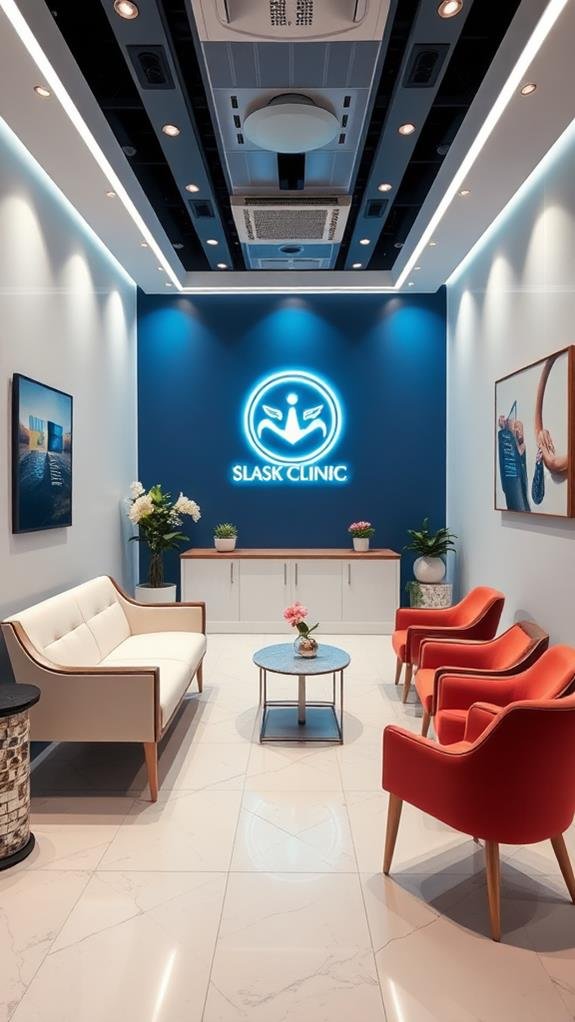5 Essential Tips for Effective Clinic Interior Design
For effective clinic interior design, start by prioritizing patient comfort with soothing colors and supportive seating. Next, optimize space efficiency by creating clear pathways and using multi-purpose furniture. Incorporate brand elements, like colors and logos, to create a unified look that reflects your clinic’s values. Improve natural lighting with large windows or light-colored furnishings to create a bright atmosphere. Finally, choose an appropriate color scheme that evokes calming feelings, such as soft blues or warm yellows. By following these tips, you’ll create a welcoming space that promotes healing and satisfaction, and there’s more to investigate for an even better design!
Key Takeaways
- Prioritize patient comfort with soothing colors, supportive seating, and calming decor to create a welcoming environment.
- Optimize space efficiency by creating clear pathways and utilizing multi-purpose furniture to improve patient and staff movement.
- Incorporate brand elements consistently through wall colors, furniture, and signage for immediate recognition and connection to the clinic’s identity.
- Enhance natural lighting through large windows, strategic room placements, and reflective surfaces to promote a bright and inviting atmosphere.
- Choose an appropriate color scheme that combines soft, calming hues with brand colors to create a cohesive and pleasant experience.
Prioritize Patient Comfort

Creating a soothing environment is essential when prioritizing patient comfort in clinic design. Start by using calming colors like soft blues or greens, which can help reduce anxiety.
Comfortable seating is a must; make certain chairs are supportive and arranged to promote a sense of privacy. Natural light can also play a big role, so consider large windows or light-filtering shades to create an inviting atmosphere.
Including plants or artwork can make the space feel more welcoming, too. Keep noise levels low; sound-absorbing materials can help create a peaceful environment.
Optimize Space Efficiency

Designing a clinic goes beyond prioritizing patient comfort; it also involves optimizing space efficiency to maximize functionality.
Start by evaluating your current layout and identify bottlenecks. You want to create clear pathways, so patients and staff can move easily without feeling cramped.
Use furniture that serves multiple purposes, like storage benches or collapsible tables, to save room.
Consider open spaces where possible, as they can make the clinic feel larger and more welcoming.
Don’t forget about vertical space—install shelves or cabinets to keep the floor clear.
Finally, make sure all areas are easily accessible, especially for those with mobility issues.
Incorporate Brand Elements

Brand elements are essential in establishing a clinic’s identity and making a lasting impression on patients.
You’ll want to incorporate your brand’s colors, logo, and messaging throughout your clinic’s design. For example, using your brand’s colors on walls or furniture helps create a unified look.
Adding your logo to the waiting area or signage can strengthen recognition. Consider choosing décor that reflects your clinic’s values and services, whether it’s modern and sleek or warm and inviting.
When patients walk in, they should feel an immediate connection to your brand.
Remember, these elements not only promote your identity but also can boost patient trust and comfort, making their experience more enjoyable and memorable.
Enhance Natural Lighting

Natural lighting can transform your clinic’s atmosphere, making it feel more open and inviting. To improve natural light, consider large windows or skylights that allow sunlight to flood in. If possible, position waiting areas or consultation rooms near these light sources.
You can also use light-colored curtains or blinds that let in sunlight while providing some privacy. Reflective surfaces like mirrors or glass can help distribute light throughout the space, brightening darker corners.
When choosing furniture, opt for lighter colors to complement the natural light and create a cohesive look. Additionally, you might want to keep the layout open and airy, reducing obstacles that can block light.
Choose Appropriate Color Scheme

Choosing the right color scheme for your clinic can considerably impact the overall mood and feel of the space.
Colors can evoke emotions and set the tone for your practice, so it’s important to select them wisely. Soft, neutral colors like light blue or green create a calm and soothing environment, helping patients feel more relaxed. Meanwhile, warmer shades, such as soft yellows or peaches, can instill a sense of comfort and friendliness.
You should also consider your clinic’s branding—integrating your brand colors can aid in creating a cohesive look.
Finally, balance is key; make sure that your color choices harmonize with furnishings and decor.
Conclusion
In summary, designing a clinic that’s both functional and welcoming is vital for patient satisfaction. By prioritizing comfort, using space efficiently, and adding your brand’s touch, you create a positive experience. Don’t forget the importance of natural light and color schemes either; they can change the entire mood of your clinic. Remember, a well-thought-out design not only helps patients feel at ease, but it also reflects your commitment to their care and well-being. Happy designing!
